Filicis, FernMale FernDarubataris (Unani) Mian Ma (TCM) |

|
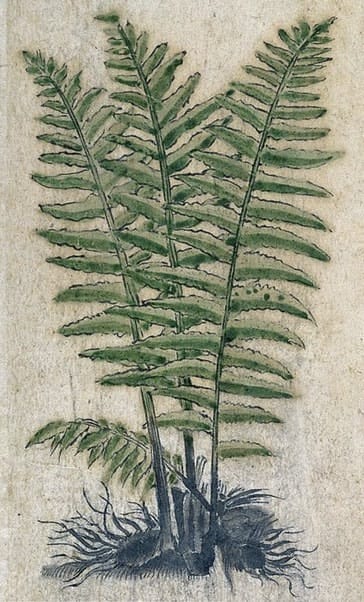 Japanese Herbal, 17th century (Welcome)
Japanese Herbal, 17th century (Welcome)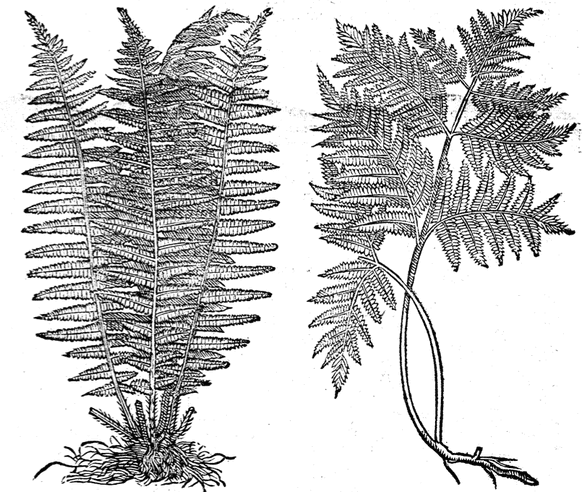 Male Fern Female Fern
Male Fern Female FernDioscorides Materia Medica, Mathias, 1563
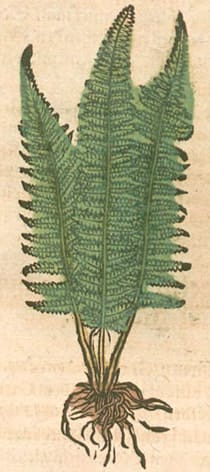
|
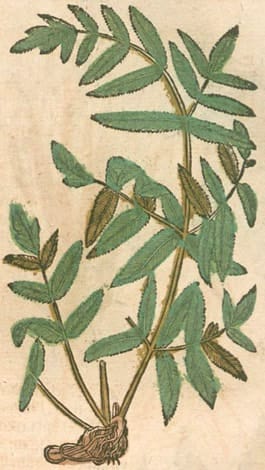
|
Krauterbuch, Lonitzer, 1578
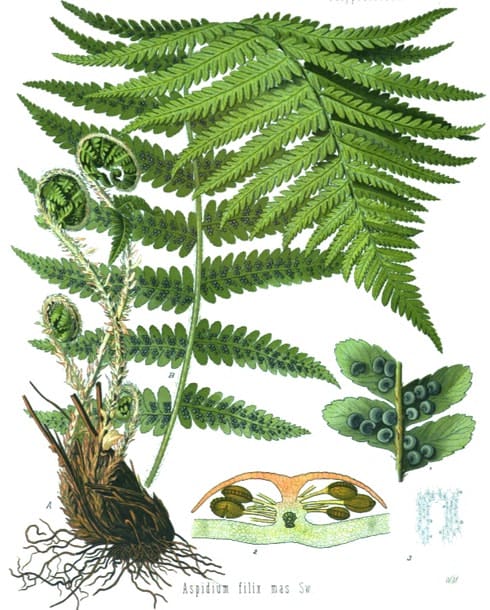 Male Fern
Male FernKoehler’s Medizinal Pflanzen, 1887
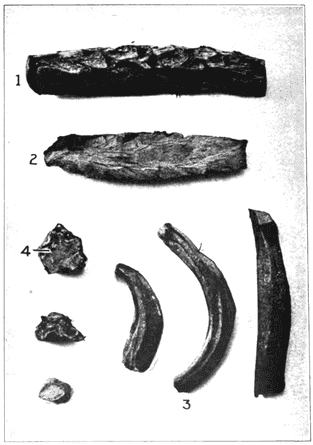
|
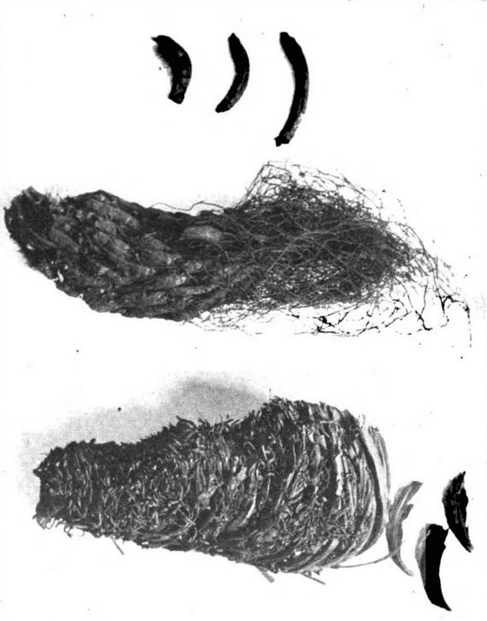
|
|
Male Fern root 1, Outer part of rhizome showing stipe scars. 2, Longitudinal section of rhizome showing conducting strands. 3. Curved and furrowed stipe base. 4, Cross-section of rhizome. (Squibb’s Atlas of the Official Drugs, Mansfield, 1919) |
Male Fern root Top: Stipe bases; Bottom: root and rhizome. A Text Book of Pharmacognosy Heber Wilkinson Youngken, 1921 |
Botanical name:
Filicis, Dryopteris
1. Male Fern: Dryopteris filix-mas (syn. Polypodium filix-mas, Aspidium filix-mas, Polystichum filix-mas, Lastrea filix-mas)
2. Marginal Fern: Dryopteris marginalis (American species used synonymously with Male Fern)
3. Female Fern: Athyrium filix-femina (syn. Polypodium filix-femina)
4. Dryopteris chrysocoma is also used in Unani
Other Ferns were used similarly, including ‘Great Forest Fern’ in Germany.
Parts used:
Root, Rhizome
Temperature & Taste:
Warm, dry. Bitter
“It is strongly hot and desiccant [dry]” … “Its roots … have some Sweetness, Pungency, Bitterness and Astringency”. (Avicenna)
Uses:
1. Clears Heat and Toxin: (TCM, Ayurveda)
-Common Cold and Flu with Fever; Acute Fever (TCM, Ayurveda)
–Encephalitis B, epidemic parotitis, measles papules (TCM)
2. Cools the Blood, Regulates Menstruation, Stops Bleeding:
-Uterine Bleeding, Flooding, Spotting between periods (TCM)
-Amenorrhea (West)
-’expel the Child in the Womb’. (Salmon); Abortifacient (West, Unani)
-it has been used as a contraceptive, taken with Honey (Unani)
3. Clears Damp, Opens Obstruction: (West, TCM)
-Edema, Strangury (TCM)
-Splenetic; used for obstructions of the Spleen, Womb and Bowels
4. Clears Wind-Damp, Benefits Bones: (West, Ayurveda)
-Muscle and Nerve pain
-Rheumatism; Sciatica (int. & ext.)
-Gout (API)
-Rickets in Children (West)
-“Some physicians believe it to be useful in Paralysis, Facial Paralysis and Arthralgia”. (Avicenna)
5. Kills Worms: (West, TCM, Ayurveda)
-especially Tapeworm
6. Externally:
-Wounds; especially moist and oozing wounds, the powder of the leaf or rhizome can be applied to dry.
-Herpes
-Mucilage is applied to Burns
-decoction of the herb or root as a wash, or the oil in which the herb has been boiled, kills Lice.
Dose:
1. ‘Those who take it must first eat Garlic’. (Dioscorides)
2. For Worms, it’s best to take a dose before bed, and a purgative in the morning. This may be repeated several times.
3. Because it is slightly irritant, it should always be taken with Corrective medicines (Unani)
4. Pliny prescibed the root with Honey for Worms, but with Sweet Wine for other cases.
Powder: 500mg–3 grams (to 1 dram);
For Worms: 3 grams (or 1 dram) of the powder is given per dose to an adult for Tapeworm; 500mg–1 gram to children.
Dioscorides prescribed a dose of 4 drams with Hydromel for Worms
Correctives:
1. Gum Arabic, Tragacanth (Unani)
2. Mastic (Unani)
3. Licorice
4. Tamarind
5. Honey; Hydromel. (Dioscorides)
Substitutes:
1. Mallotus philippensis (Unani)
2. Rottleria tinctoria (Unani)

Main Combinations:
1. Worms:
i. Fern root, Pumpkin seed, Garlic (equal parts), taken at night, followed by a purgative in the morning.
ii. Tamarind Pulp (8 parts Fern extract: 22 parts Tamarind Pulp, with Sugar, qs.)
iii. Fern root with Tansy and Wormwood
iv. Fern root (1 scruple), Gamboge (2 grains). Mix for a dose. (Dispensatorium Fuldense, 1791)
v. Fern root, Rhubarb, Wormseed, Corsican Sea-moss (1 oz. each). (Pharmacopoeia Wirtembergica, 1798)
vi. Fern root, Mulberry bark (2 drams each), Scordium (1 scruple), Syrup of Wormwood, sufficient to form a Bolus. (Memorial Pharmaceutique, 1824)
vii. Fern root, Scammony (Dioscorides)
2. Tapeworm:
i. Fern root, Calamus
ii. Fern root, Valerian (equal parts), form an Electuary with clarified Honey. Dose: 1–2 teaspoonfuls. (Sobernheim, 1840)
3. Sclerosis of the Spleen, Fern root, Wormwood, Savin tops (equal parts). This was commended. (Ettmuller)
Cautions:
1. Not used during Pregnancy
2. Avoid overdose
3. Not used in Anemia, Cardiopathy, Diabetes, Hepatosis, Nephrosis (Duke)
4. “It causes thinning and removal of hair because of its bitter and putrefactive nature”. (Avicenna)
Toxicity:
One of the main active ingredients, filicin, can cause cramps, blindness and liver damage in excess dose.
Main Preparations used:
-
Extra Info
-
History
|
‘Of fern there are two varieties, equally destitute of blossom and of seed. The Greeks give the name of “pteris,” and sometimes “blachnon,” to the kind in which numerous shoots take their rise from a single root, exceeding two cubits even in length, and with a not unpleasant smell: this plant is thought to be the male fern. ‘The other kind is known to the Greeks as “thelypteris,” and sometimes, “nymphaja pteris:” it has a single stem only, with comparatively few branches, is shorter, softer, and more tufted than the other, and has channelled leaves growing near the root. Swine are fattened upon the roots of either kind. The leaves of both kinds are arranged on either side in the form of wings, whence the Greek name “pteris.” The roots. are long, run obliquely, and are of a swarthy colour, more particularly when dried: when wanted for nee, they should be dried in the sun. These plants are found growing everywhere, but in cold soils more particularly; they should be taken up, too, at the setting of the Vergiliae. The root is only used at the end of three years, neither before that period nor after. They act as an expellent of intestinal worms; for |
tapeworm honey is taken with them, but in other cases sweet wine, for three days. ‘They are, both of them, extremely detrimental to the sto mach, but are laxative to the bowels, carrying off first the bile and then the aqueous humours of the body. When used for tapeworm, it is the best plan to take scammony with them, in equal proportions. For rheumatic defluxions, the root is taken in doses of two oboli, in water, after a day’s abstinence from food, a little honey being taken first. Neither kind must ever be given to females; for in pregnancy they are productive of abortion, and in other cases entail sterility. Powdered fem is sprinkled upon sordid ulcers, as also upon the necks of beasts of burden, when chafed. Fern-leaves kill bugs, and serpents will never harbour among them: hence it is a good plan to strew them in places where the presence of those reptiles is suspected. The very smell, too, of burnt fern will put serpents to flight. Medical men have made this distinction as to ferns; that of Macedonia, they say, is the best, and that of Cassiope the next. (The Natural History of Pliny, trans. by Bostock and Riley, Vol. 5, 1856) |
Pharmacographia, Fluckiger & Hanbury, 1879:
|
‘The use of the rhizome of ferns as a vermifuge was well known to the ancients, as Theophrastus, Dioscorides and Pliny all giving curious descriptions of the plant. The remedy would appear to have been administered also during the middle ages, for it was again noticed by Valerius Cordus, and had a place in German pharmaceutical tariffs of the sixteenth century as well as in Schroder’s Dispensatory. Yet Tragus‘ remarks that, at least in Germany, the root was little used. It was in fact subsequently nearly forgotten until revived by the introduction of certain secret remedies for tapeworm, of which powdered male fern rhizome, combined with drastic purgatives, was a chief constituent. A medicine of this kind was prepared by Daniel Mathieu, a native of Neuchatel, born in 1741, who established himself as an apothecary in Berlin. His treatment for the parasite was so successful that it attracted the notice of Frederick the Great, who purchased his nostrum for an annuity of 200 thalers (£30), besides conferring upon him |
the dignity of Aulic Councillor. Great celebrity was also gained for the method of treating tapeworm practised by Madame Nuffler or Nuffer, the widow of a surgeon at Murten (Morat), likewise in Switzerland, who in 1775 obtained for the secret from Louis XIV., after an inquiry by savans of the period, the sum of 18,000 livres. Her method of treatment consisted in the administration of—1. Panada made of bread with a little butter. 2. A clyster of salt water and olive oil. 3. The “spicifique“— simply powdered fern-root. 4. A purgative bolus of calomel, gamboge, scammony, and Confectio hyacinthidis,— given in the foregoing order. ‘J. Peschier, a pharmacien of Geneva, recommended as a substitute for the bulky powder of the root, an ethereal extract, an efficient preparation, which though proposed in 1825, was scarcely used in England until about 1851; at present it is the only form in which male fern is employed. Peschier already observed a crystallized deposit in his extract.’ |
